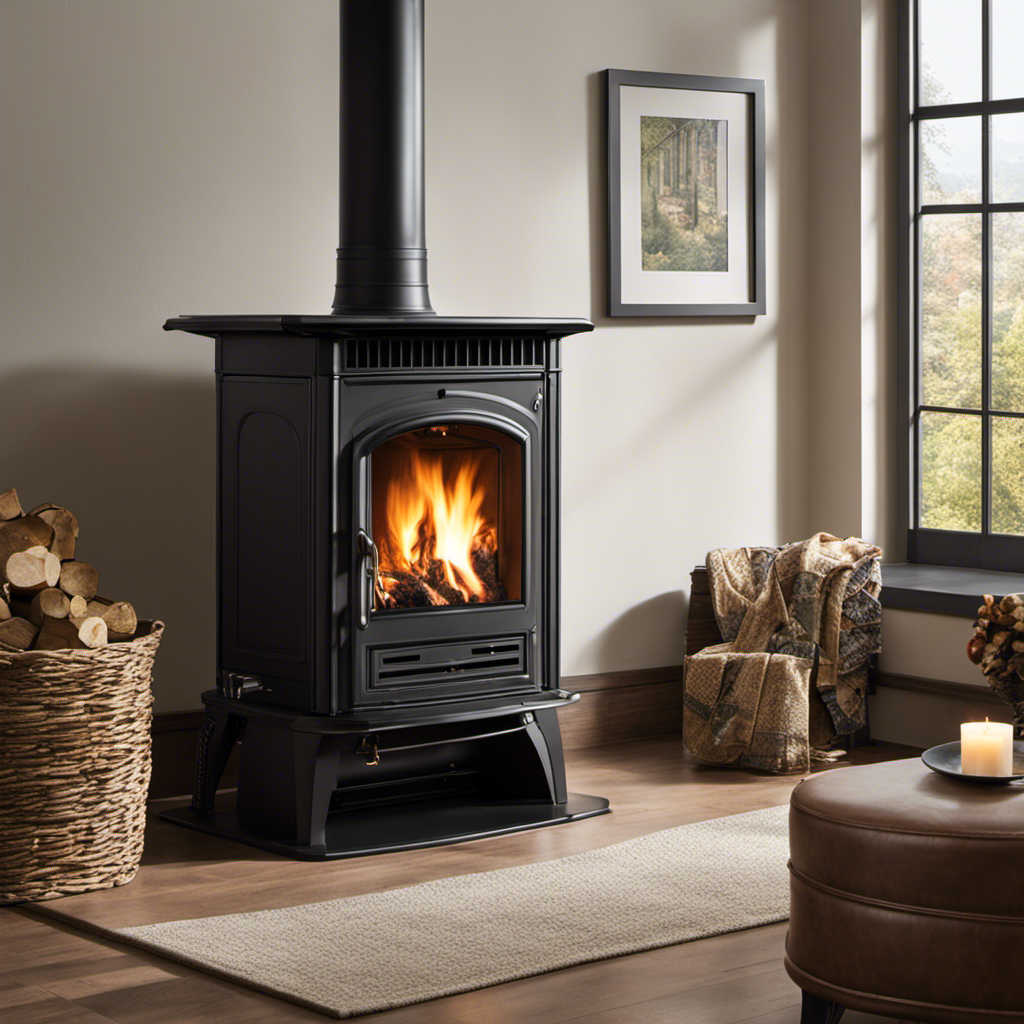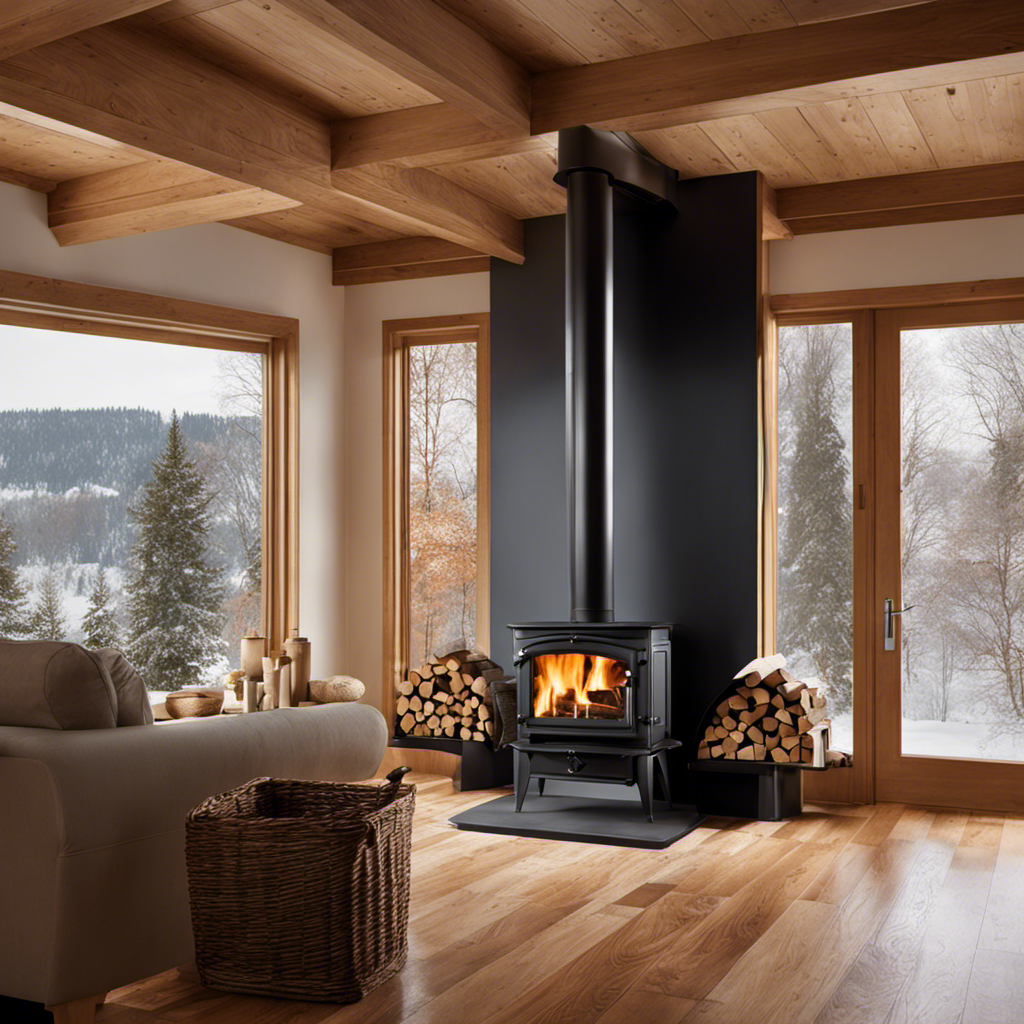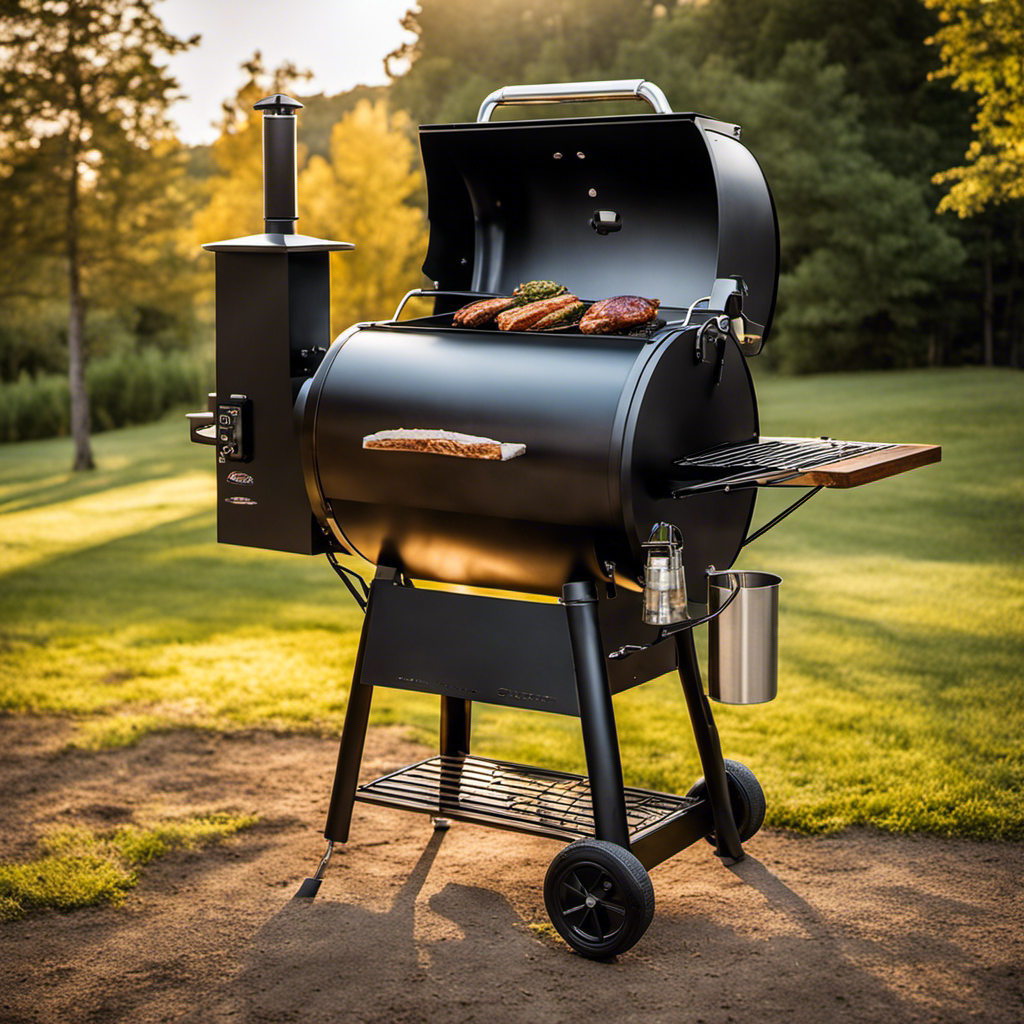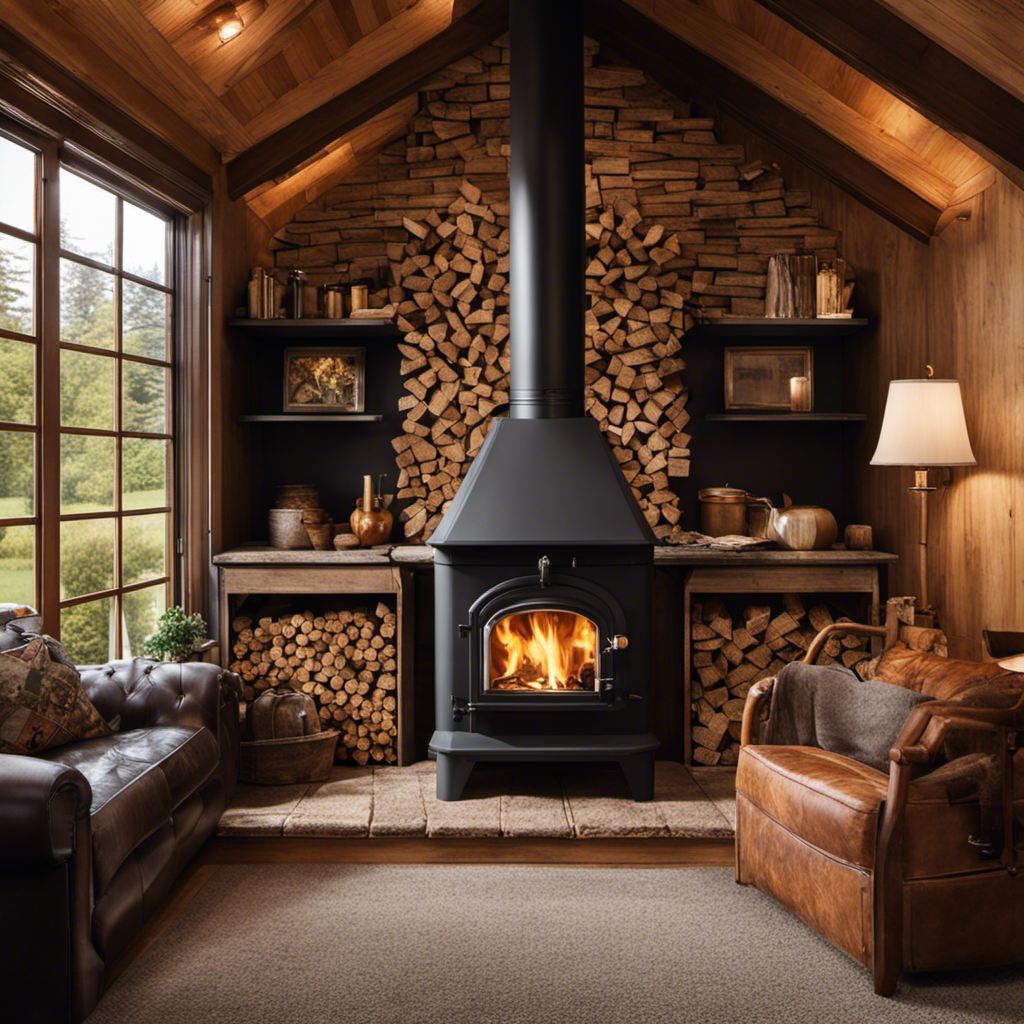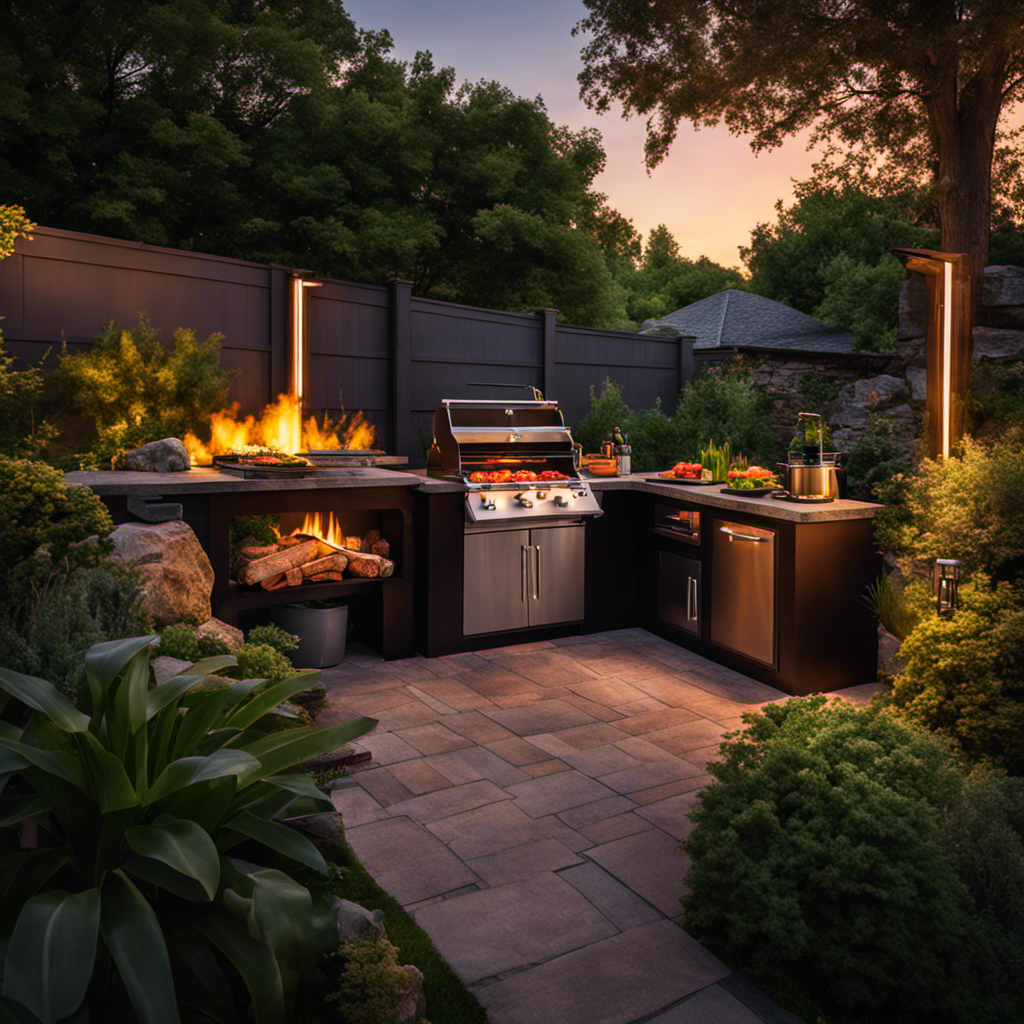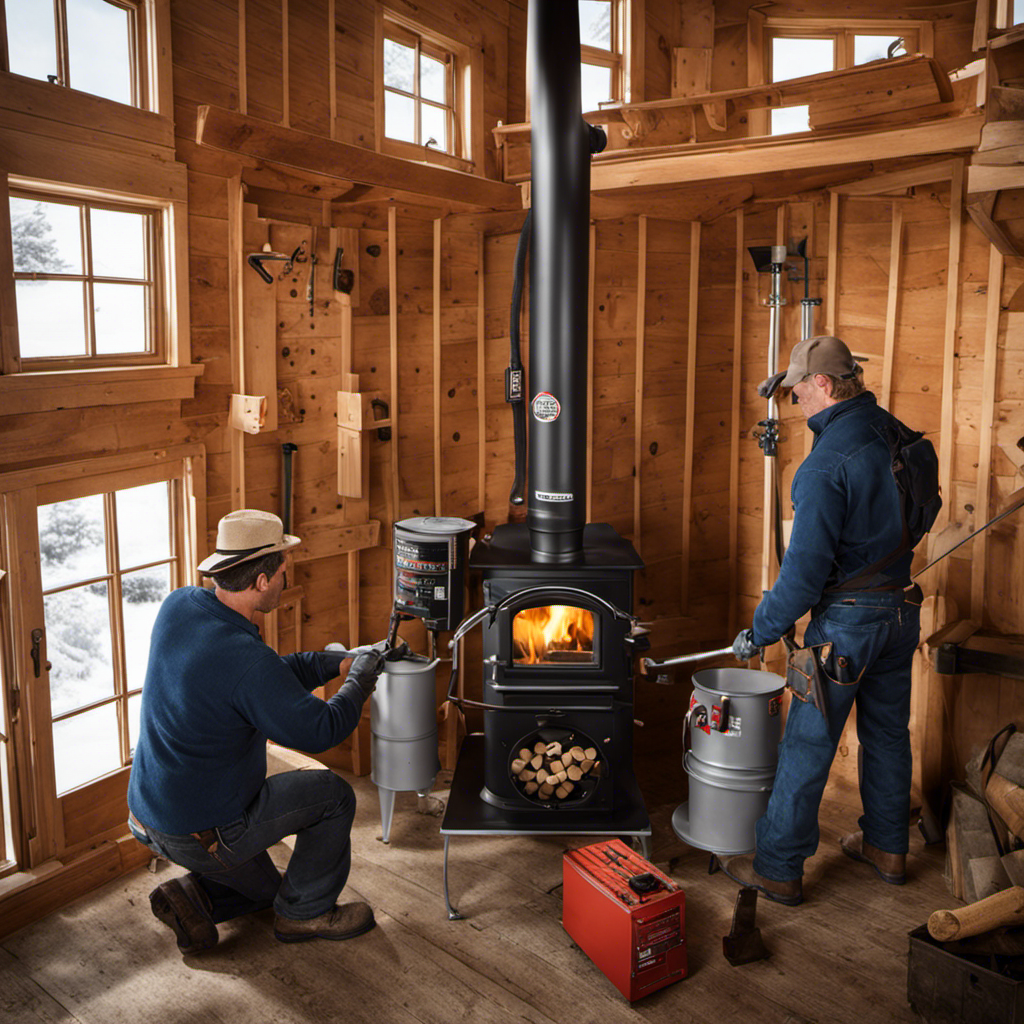As a seasoned homeowner, I frequently toy with the idea of replacing my reliable wood stove with a pellet stove, which is renowned for its higher efficiency and ease of use. However, I wonder, can the new pellet stove be installed in the precise location of my former wood stove?
In this article, we’ll explore the benefits of making the switch, assess the compatibility of your existing chimney, and delve into the necessary modifications for installation. Plus, we’ll discuss the crucial factors to consider when choosing the right location and whether to hire a professional or tackle the installation yourself.
Let’s dive in!
Key Takeaways
- Switching from a wood stove to a pellet stove offers benefits such as increased efficiency and environmental friendliness.
- Assess the compatibility of your existing chimney for a pellet stove using a checklist to ensure it meets necessary requirements.
- Necessary chimney modifications may be required for proper venting and safety when installing a pellet stove.
- Safety precautions should be taken during the removal and disposal of the old wood stove, including proper ventilation and contacting local waste management or recycling facilities.
Benefits of Switching From a Wood Stove to a Pellet Stove
There are several benefits of switching from a wood stove to a pellet stove.
Pellet stoves offer a more efficient and environmentally friendly heating option compared to wood stoves.
One of the main advantages is the convenience they provide. With a pellet stove, you don’t have to constantly feed it with firewood. Instead, you can simply load the hopper with pellets, and the stove will automatically feed them into the combustion chamber as needed. This eliminates the need for constant monitoring and refueling.
Additionally, pellet stoves produce less smoke and ash compared to wood stoves, resulting in cleaner indoor air quality. They also have a higher heating efficiency, as they can burn pellets more completely. This means you get more heat output per unit of fuel.
In the next section, we will discuss how to assess the compatibility of your existing chimney for a pellet stove.
Assessing the Compatibility of Your Existing Chimney for a Pellet Stove
When considering switching from a wood stove to a pellet stove, it’s crucial to assess the compatibility of your existing chimney. To do this, you can use a chimney compatibility checklist to ensure that your chimney meets the necessary requirements for a pellet stove installation.
In some cases, necessary chimney modifications may be required to ensure proper venting and safety for your pellet stove.
Chimney Compatibility Checklist
You’ll need to check the chimney compatibility checklist to ensure your new pellet stove can be hooked up where your wood stove was.
Chimney installation is a crucial aspect when it comes to pellet stove maintenance. Before making any modifications, it’s important to assess if your existing chimney is suitable for a pellet stove.
The checklist will guide you through the key points to consider. First, check the size and condition of the chimney. Pellet stoves require specific venting systems, so make sure your chimney meets the necessary standards.
Next, inspect the clearance requirements. Pellet stoves need proper clearance from combustible materials to ensure safe operation. Additionally, assess the condition of the chimney liner and ensure it is in good shape.
Necessary Chimney Modifications
To determine if necessary modifications are needed for your chimney, assess the condition of the chimney liner and ensure it meets the required standards for a pellet stove.
Chimney maintenance is crucial to ensure safe and efficient operation of your pellet stove. A damaged or deteriorated chimney liner can pose serious risks, such as carbon monoxide leakage or chimney fires. Regular inspections and cleanings are essential to identify any issues early on.
When considering the cost of chimney maintenance, it is important to factor in the potential savings from improved efficiency and reduced fuel consumption.
Understanding the necessary modifications for installing a pellet stove involves assessing the chimney’s size, draft, and clearance requirements. By making these necessary modifications, you can ensure a seamless and safe installation of your pellet stove.
Understanding the Necessary Modifications for Installing a Pellet Stove
Sure, it’s important to understand the necessary modifications for installing a pellet stove where your wood stove used to be. Here are three key modifications required for a successful installation process:
-
Chimney liner: A pellet stove requires a specific type of chimney liner to ensure proper venting. This liner is typically made of stainless steel and is designed to accommodate the higher temperatures produced by the pellet stove.
-
Electrical wiring: Unlike a traditional wood stove, a pellet stove requires electricity to operate. You will need to have an electrical outlet installed near the stove to power the ignition system, fans, and controls.
-
Air intake and exhaust: Pellet stoves require both an air intake and an exhaust vent. These vents need to be properly positioned to ensure efficient combustion and proper ventilation.
Understanding these modifications will help you prepare for the installation of your new pellet stove. Once you have made the necessary adjustments, you can proceed with safely removing and disposing of your old wood stove.
Steps to Safely Remove and Dispose of Your Old Wood Stove
When it comes to removing an old wood stove, it’s crucial to prioritize safety precautions. Before starting the removal process, make sure to turn off the power supply and disconnect any gas lines or pipes.
Proper disposal methods should also be followed, such as contacting a professional to handle the removal and disposal of any hazardous materials.
Additionally, when considering the installation of a pellet stove, it’s important to take into account factors such as the size and location of the stove, ventilation requirements, and any necessary modifications to the existing chimney or flue system.
Safety Precautions for Removal
Before removing your wood stove and hooking up the pellet stove, it’s important to take safety precautions. Here are three key safety measures to consider during the removal process:
-
Ensure proper ventilation: Before starting any work, make sure the area is well-ventilated to prevent the buildup of harmful gases. Open windows and doors to allow fresh air to circulate.
-
Disconnect the power supply: Before removing the wood stove, turn off the power supply to avoid any electrical accidents. This will also prevent any sparks or electrical hazards during the removal process.
-
Use protective gear: It’s crucial to wear appropriate safety gear, including gloves, goggles, and a dust mask, to protect yourself from potential injuries and harmful particles.
By following these removal precautions and safety measures, you can minimize the risk of accidents and ensure a safe transition to your new pellet stove.
Now, let’s explore the proper disposal methods for your old wood stove.
Proper Disposal Methods
To properly dispose of your old wood stove, you can contact your local waste management facility for guidance and instructions. They will be able to provide you with proper disposal methods that are both environmentally friendly and compliant with local regulations.
One option for disposing of your old wood stove is to recycle it. Many waste management facilities have recycling programs in place for metal appliances like wood stoves. Recycling not only helps to reduce waste in landfills, but it also allows for the extraction and reuse of valuable materials.
Another option is to donate your old wood stove if it is still in working condition. There may be individuals or organizations in need of a wood stove who would greatly appreciate your donation.
When considering installation of a pellet stove to replace your old wood stove, there are several important considerations to keep in mind.
Installation Considerations for Pellet Stove
One important consideration when installing a pellet stove is the availability of a proper ventilation system. Without proper ventilation, the stove may not function efficiently and can pose serious health risks.
Here are three key installation considerations for a pellet stove:
-
Venting Requirements: Pellet stoves require a venting system to remove combustion gases. This can be achieved through a direct vent system, which uses an exterior wall for venting, or a chimney vent system, which utilizes an existing chimney. It is important to follow manufacturer guidelines and local building codes when choosing the appropriate venting option.
-
Clearances: Pellet stoves require specific clearances from combustible materials such as walls, furniture, and curtains. Proper clearances ensure safe operation and prevent fire hazards. Be sure to carefully measure and adhere to the recommended clearances during installation.
-
Maintenance Requirements: Regular maintenance is crucial for the safe and efficient operation of a pellet stove. This includes cleaning the stove and venting system, inspecting and replacing gaskets and seals, and checking for any signs of wear or damage. Following the manufacturer’s maintenance guidelines will help extend the lifespan of the stove and prevent costly repairs.
Considering these installation considerations and maintenance requirements will ensure a safe and efficient pellet stove.
Now, let’s move on to choosing the right location for your new pellet stove.
Choosing the Right Location for Your New Pellet Stove
Sure, you can hook up your new pellet stove in the same location where your wood stove used to be. Pellet stoves offer numerous benefits, such as their efficiency, low emissions, and convenience. However, before installing your pellet stove, there are some important factors to consider.
First, ensure that your chosen location has adequate space and clearance requirements for the stove. This is crucial for proper ventilation and safety. Additionally, consider the proximity to an exterior wall for venting purposes.
It is also important to have access to a power source, as pellet stoves require electricity to operate. Lastly, be mindful of any combustible materials nearby that could pose a fire hazard.
With these considerations in mind, you can confidently proceed with installing your new pellet stove and enjoy its many advantages. Now, let’s discuss the proper ventilation and clearance requirements for pellet stoves.
Proper Ventilation and Clearance Requirements for Pellet Stoves
Before installing your new pellet stove, it’s important to consider the proper ventilation and clearance requirements. This ensures that your stove operates efficiently and safely. Here are three key factors to keep in mind:
-
Ventilation: Pellet stoves require proper ventilation to remove combustion gases. Make sure your stove is vented to the outside, using a dedicated vent pipe that meets local codes and regulations.
-
Clearance: Pellet stoves need adequate clearance from combustible materials. Check the manufacturer’s guidelines for the specific clearance distances required for your stove model. This includes walls, furniture, and other objects that could potentially catch fire.
-
Proper maintenance: Regular maintenance is essential for the optimal performance of your pellet stove. This includes cleaning the stove, inspecting components, and ensuring proper airflow. Following the manufacturer’s maintenance instructions will help prolong the lifespan of your stove.
By understanding these ventilation and clearance requirements, as well as practicing proper maintenance and troubleshooting techniques, you can enjoy the warmth and efficiency of your pellet stove.
Now, let’s explore the factors to consider when deciding between hiring a professional or undertaking a DIY installation.
Hiring a Professional Versus DIY Installation: Factors to Consider
Hiring a professional or doing it yourself: there are several factors to consider when deciding how to install your new pellet stove.
While DIY installation may seem like a cost-effective option, it’s important to weigh the risks and benefits.
Hiring professionals ensures that the installation is done correctly and safely, minimizing the chances of any potential hazards. They have the expertise and experience to handle the technical aspects of the installation process, such as connecting the stove to the chimney and ensuring proper ventilation.
Additionally, professionals can provide valuable advice on selecting the right location for your pellet stove and help you comply with any local building codes.
Investing in professional installation can give you peace of mind and ensure the longevity and efficiency of your new pellet stove.
Is it Safe to Replace a Wood Stove with a Pellet Stove in the Same Location?
Yes, placing a pellet stove after a wood stove in the same location is generally safe. However, it is important to ensure that the proper venting and clearance requirements are met for the new pellet stove. Consulting with a professional installer is recommended to guarantee a safe and effective transition.
Is it Safe to Replace a Wood Stove with a Pellet Stove in the Same Location?
Yes, it is safe to put a pellet stove where the wood stove is located. Both types of stoves require proper ventilation and safety precautions, but as long as the installation is done correctly and the necessary adjustments are made, it is a viable option.
Frequently Asked Questions
What Are the Cost Savings of Switching From a Wood Stove to a Pellet Stove?
When considering the cost comparison between a wood stove and a pellet stove, it’s important to note the fuel efficiency of each. Pellet stoves are generally more efficient, resulting in potential long-term cost savings.
How Do I Properly Clean and Maintain a Pellet Stove?
Proper pellet stove maintenance is crucial for optimal performance. Avoid common cleaning mistakes by regularly removing ash and cleaning the exhaust vent. Like a well-tuned instrument, a well-maintained pellet stove will provide warmth and efficiency.
Can I Use My Existing Wood Stove Hearth or Do I Need to Make Modifications?
Yes, you can use your existing wood stove hearth for your new pellet stove, but modifications may be needed. It’s important to consult the manufacturer’s guidelines and a professional to ensure proper installation and safety.
Are There Any Specific Building Codes or Permits Required for Installing a Pellet Stove?
Building codes and permits are necessary when installing a pellet stove. It is important to consult local regulations to ensure compliance. Proper installation and adherence to codes will ensure safety and efficiency.
Are Pellet Stoves Environmentally Friendly Compared to Wood Stoves?
Compared to wood stoves, pellet stoves are more efficient and environmentally friendly. They burn cleaner, produce less pollution, and have higher heating efficiency. However, proper installation is crucial for optimal performance.
Conclusion
In conclusion, transitioning from a wood stove to a pellet stove offers a multitude of benefits.
By assessing the compatibility of your existing chimney and understanding the necessary modifications, you can safely install your new pellet stove.
Proper location selection, ventilation, and clearance requirements must be considered for optimal performance.
While hiring a professional ensures expertise, DIY installation can be a cost-effective option for the technically inclined.
Embrace this efficient and eco-friendly heating solution, and experience the warmth and convenience it brings to your home.
Logan’s affair with adventure began in childhood. He hailed from a small town where vast forests bordered one side and endless shores stretched on the other. His days were spent exploring uncharted woods, climbing tall trees, or listening to the tales of old sailors. This early immersion in a world brimming with stories and mysteries became the foundation of his passion for writing.

